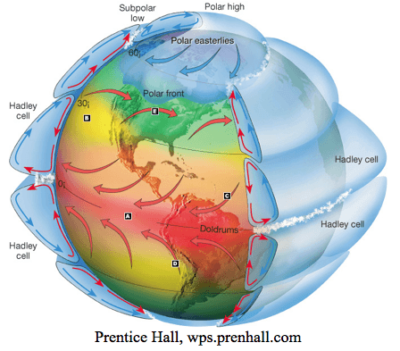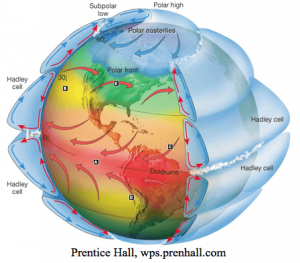
The trade winds are a prevailing pattern of easterly winds found between latitudes of 30 degrees North and 30 degrees south. They have long been known to explorers from the time of early trans-Atlantic crossings. This pattern is formed because sunlight strikes Earth’s surface at varying angles along the planet’s curvature.

Earth’s atmosphere responds to the sun’s uneven heating by flowing in vast, circulating beltways that create stable wind patterns. Equatorial regions receive more direct sunlight, creating a surplus of radiant heat energy that drives the convection of air masses called atmospheric circulation cells. We owe the predictability of regional surface winds to the turnover of these cells, which was exploited by early merchant sailors, leading to their designation as trade winds (also known as easterlies).
 Three types of atmospheric cells exist on our planet, but only one is responsible for the trade winds: Hadley cells. Straddling the equator, Hadley cells cycle hot tropical air northward where they collide with the Ferrel cells of temperate latitudes. This convection is driven by the surplus heat of the tropics where infrared (heat) radiation exceeds incoming ultraviolet light. The initially hot, high-pressure air within Hadley cells rises into the upper atmosphere, precipitating almost all of its moisture, and moving away from the equator.
Three types of atmospheric cells exist on our planet, but only one is responsible for the trade winds: Hadley cells. Straddling the equator, Hadley cells cycle hot tropical air northward where they collide with the Ferrel cells of temperate latitudes. This convection is driven by the surplus heat of the tropics where infrared (heat) radiation exceeds incoming ultraviolet light. The initially hot, high-pressure air within Hadley cells rises into the upper atmosphere, precipitating almost all of its moisture, and moving away from the equator.
 Upon reaching the mid-latitudes, this air has become sufficiently cool and dense to plummet towards Earth’s surface where it is split and rerouted towards the equator and the poles. This rerouted air creates currents of surface wind as the cycle is completed.
Upon reaching the mid-latitudes, this air has become sufficiently cool and dense to plummet towards Earth’s surface where it is split and rerouted towards the equator and the poles. This rerouted air creates currents of surface wind as the cycle is completed.
 Why then do winds not drive due south? Earth’s steady rotation beneath its atmosphere ensures that as winds blow south they also move west against this rotation. This phenomenon, called the Coriolis effect, is the apparent deflection of air as it circulates north-south along Earth’s surface. Trade winds are a byproduct of this effect, flowing northeast to southwest in the northern hemisphere.
Why then do winds not drive due south? Earth’s steady rotation beneath its atmosphere ensures that as winds blow south they also move west against this rotation. This phenomenon, called the Coriolis effect, is the apparent deflection of air as it circulates north-south along Earth’s surface. Trade winds are a byproduct of this effect, flowing northeast to southwest in the northern hemisphere.



